高中英语必修四 unit3 课文教学设计
- 格式:docx
- 大小:22.12 KB
- 文档页数:5
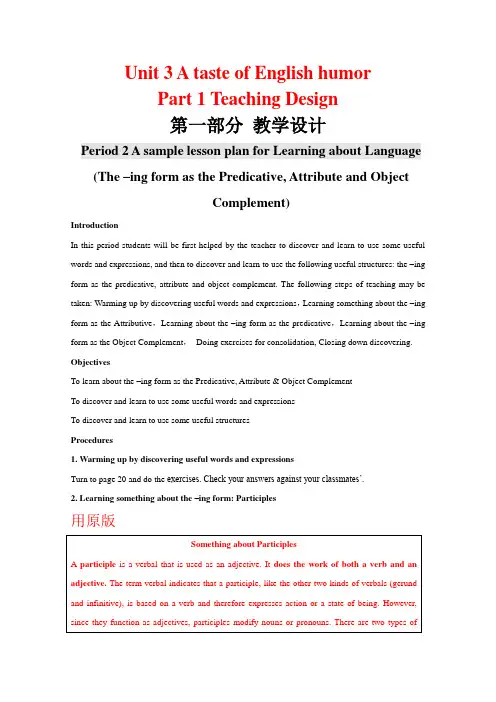
Unit 3 A taste of English humorPart 1 Teaching Design第一部分教学设计Period 2 A sample lesson plan for Learning about Language (The –ing form as the Predicative, Attribute and ObjectComplement)IntroductionIn this period students will be first helped by the teacher to discover and learn to use some useful words and expressions, and then to discover and learn to use the following useful structures: the –ing form as the predicative, attribute and object complement. The following steps of teaching may be taken: Warming up by discovering useful words and expressions,Learning something about the –ing form as the Attributive,Learning about the –ing form as the predicative,Learning about the –ing form as the Object Complement,Doing exercises for consolidation, Closing down discovering. ObjectivesTo learn about the –ing form as the Predicative, Attribute & Object ComplementTo discover and learn to use some useful words and expressionsTo discover and learn to use some useful structuresProcedures1. Warming up by discovering useful words and expressionsTurn to page 20 and do the exercises. Check your answers against your classmates’.2. Learning something about the –ing form: Participles用原版Find the participial phrases in these sentences and tell what word they modify.1. The man running slowly still finished the race.2. The boy having been scolded finally did his work.3. The teacher, having retired, could now travel widely.4. The soldier, having saluted his superior, continued on his way.5. The truck swerving and sliding hit the brick wall.Keys:1. running slowly modifies man2. having been scolded modifies boy3. having retired modifies teacher4. having saluted his superior modifies soldier5. swerving and sliding modifies truck3. Doing exercises for consolidation4. Closing down by discoveringTo end the period you are going to skim the text and the previous texts to find out all the examples containing –ing forms used as the predicative, attributive and object.Unit 3 A taste of English humorPart 1 Teaching Design第一部分教学设计Period 3 A sample lesson plan for Using Language(English jokes)IntroductionLanguage is learned to be used in and for communication. So in this period we shall have the students read, listen, write and speak in English, making use of the focused words, expressions, structures and topic ideas covered in this unit. Warming up by reading school jokes comes first to be followed by reading and underlining and doing the exercises. Guided speaking and writing will lead to the end of the period: closing down by acting.ObjectivesTo enjoy reading the paragraph of Jokes about Sherlock Holmes and Doctor WatsonTo learn to use the language by reading, listening, speaking and writingProcedures1. Warming upWarming up by reading school jokesThere are lots of jokes in English about school life. Read one to see whether you will laugh or not. 用原版2. Reading and underliningRead the paragraph and underline all the useful expressions or collocations in it. Copy them into your notebook after class as homework.3. Doing the exerciseNow you are going to do the exercise 1 on page 22.4. Guided SpeakingThink of funny stories in English and tell them to your group mates.5. Guided Writing—Learn to write jokesThere are two main parts to the structure of a joke. The first part prepares you for the laugh by telling a story which creates a sense of expectation. The second part of the joke, the punch line, provokes laughter by telling an unexpected and different story, yet one which is still compatible with the first, as in this example: “My wife just ran off with my best friend. Boy, do I miss him.” and “I had a mud pack facial done, and for three days my face loo ked much better. Then the mud fell off.” Notice the assumption that is made in both these examples. In the first, you assume the person telling the story is angry with his wife, so the punch line surprises you because he's feeling something different and unexpected. Again, in the second example, you'd most likely assume the mud had been removed, leaving the face looking better, so the punch line takes you by surprise.So, to write jokes you need to practice reading statements and writing down the assumptions you make about them. You must be able to interpret the statement (first story line) in at least two different ways in order to provide the second, different story i.e. the punch line. And what to write about? Anything that interests you. Anything you have strong opinions about.Now write down your own jokes, in English.6. Closing down by actingActing out the text is a strategy for motivating us to read out loud the text. We need oral practice and help with pronunciation and so acting out the text really helps us.To end this period, we are going to act the film by Charlie Chaplin, The Great Dictator.。

ReadingNot just watching a film…Teaching Aims:1. To learn some information about how RealCine works, why it is better than ordinary cinema, and how it can be used in many other ways.2. To teach students the basic characteristics of a business proposal.Teaching Important and Difficult Points:1. Make the students understand the reading material better.2. Master the vocabulary of virtual reality.3. Improve the students’ reading ability.4. Know the structure and language for a proposal.Teaching Approaches:1.Discussion before reading to make the students interestedin what they will learn.2.Fast reading to get a general idea of the text.3.Reading in detail to get the detailed information of thetext.4. Pair discussion and group discussion to get students to participate in the classroom activities.Interaction Patterns: Teachers -class, individuals, pairsTeaching Aids:The multimedia, a record and a blackboard.Teaching Procedures:Step 1 Lead-inShow the video of Avatar and ask students:Do you like this film? Can you imagine how you feel when you are actually in the film?Show some pictures of 3D films and tell them virtual reality could change the way we watch films.3D film—It is a film people watch with a special pair of spectacles, which gives a three-dimensional effect with images in the dimensions of width, height and depth.4D film—It is a 3D film with an added environmental effect, such as water or wind in the cinema.Virtual reality could change the way we watch films.Step 2 SkimmingStudents are expected to skim the text and find out the answers to the questions in part A. 1.What is the name of the product?2. How many of the user’s senses does this product connect with?3. What are the advantages of using RealCine for urban palnning?Step 3 ScanningStudents are asked to scan the text and answer the questions.1) What technology is behind this product?2) What do users wear so they feel that they are really ina new world?3) What did the teenager experience in RealCine?4) Why do some people think that users will be disappointed by RealCine?5) How could firefighters be trained with this new technology?6) What might people use RealCine for?Step 4 Detailed-readingAsk students to find more information about RealCine by asking the question:How can RealCine excite the viewers’ four senses?They are asked to fill in the chart according to the proposal Sense Things needed Effects in RealCine SightHearingSmellTouchTrue (T) or false (F).2. RealCine can’t help the people who have trouble in walking walk as normal people. ( T )3.With the help of RealCine, the seventy-year-old grandfather saw and touched a lion in America. ( F )4. RealCine can allow students to experience the world as an animal while learning biology. ( T )5. According to the text, the author’s attitude towards the future of RealCine is optimistic. ( T )Step 5 ConsolidationAsk students to divide the passage into several parts and get the main idea of each part.Step 6 Reading strategyAsk students to read the strategy and fill in the blank.1. A business presentation is a plan or a suggestion that__________________.2. As a presentation is to be given to those making decisions,it has to be ________________.3. A good presentation usually includes ________________________.4. In order to make the presentation objective,______________ is frequently used.Step 7 DiscussionPart E on Page 45Answers:1) presentation 2) users 3) disappointed 4) urban5) confident 6) put forward 7) studio。
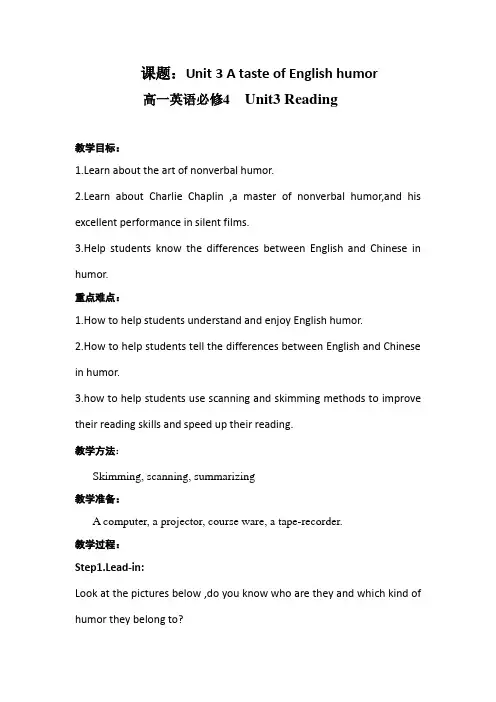
课题:Unit 3 A taste of English humor高一英语必修4Unit3 Reading教学目标:1.Learn about the art of nonverbal humor.2.Learn about Charlie Chaplin ,a master of nonverbal humor,and his excellent performance in silent films.3.Help students know the differences between English and Chinese in humor.重点难点:1.How to help students understand and enjoy English humor.2.How to help students tell the differences between English and Chinese in humor.3.how to help students use scanning and skimming methods to improve their reading skills and speed up their reading.教学方法:Skimming, scanning, summarizing教学准备:A computer, a projector, course ware, a tape-recorder.教学过程:Step1.Lead-in:Look at the pictures below ,do you know who are they and which kind of humor they belong to?Step2.Words review:(你能朗读并说出下列单词或短语的意思吗?)Performer:astonishing: Unfortunately: Ordinary:entertaining:throughout: Homeless:failure:overcome:direct: convincing Outstanding: up to now:badly off:c ut off: pick out:star in:Step3:Fast reading:(1)What’s the passage mainly about?A.The history of English humor .B.The films Charlie made.C.Charlie Chaplin and the humor he made in his films.D.The Gold Rush in California.(2)Read the passage fast and match each paragraph with its main idea. Paragraph1. A.what Charlie’s childhood was like.Paragraph2. B.What his most famous character was like Paragraph3. C.an example of a sad situation that he made funny Paragraph4. D.Why people needed cheeringParagraph5. E.his achievementsStep4:Careful-reading:Para.1:Read the first Paragraph carefully and then find out the answer to the question.What effect does Charlie Chaplin’s acting have ?Para.2:Fill in the blanks.Charlie Chaplin’s early life:●He was in a poor family in 1889 and was taught to sing anddance as a little child.●His father’s death made the family so he spent his childhood looking after his sick mother and his brother.●By his, he had become one of the most popular child actors in England.Para.3 What’s the character of Charlie’s walk around stiffly carrying a walk stick?Para.4:Put the following the sentences in the right order( )a.Chaplin tried chewing the bottom of the shoe.b.Chaplin boiled one of his leather shoes.c.Chaplin cut off the leather top of the shoe.d.Chaplin picked out the lace of the shoe.e.Chaplin ate it as if it were spaghetti.Para.5: Fill in the blanks.Achievements:●He wrote,and produce the films he starred in.●In 1972 he got a special Oscar for his work in films.●He is loves and remembered as a great actor who couldpeople with great confidence.Step5.Careful-reading: Reading the passage again and do True or False.●Charlie Chaplin was poor when he was a small boy.●People who don’t know English cannot enjoy Chaplin’s films.●In The Gold Rush Chaplin and his friends are fortunate to find somegold.●In The film the meal he eats is hard to chew.●Chaplin not only acted in films but wrote and directed films as well. Step6:Summaryof nonverbal humor, who brought laughter to people and them to go through hard times with great .Fill in the blanks according to the text.Charlie Chaplin came from a poor family. Both his parents were music hall 1. ___________(perform). He started appearing on the stage while he was still a child. After his father died, the family became even 2.______(badly)off. By his teens, Chaplin had become a popular actor in England. No one got 3. ________(bore) watching him.Later, he began making films. His charming character, the little tramp, made him 4. ________(know) throughout the world. Thischaracter was a social 5. __________ (fail) but was loved for his optimism and 6. ___________(determine) to overcome all difficulties.In The Gold Rush, the little tramp and his friend try boiling a pair of leather shoes for their dinner. Chaplin first picks 7. ______ the laces and eats them. Then he cut 8. ______ the leather top of the shoe. Finally he tries cutting and 9. __________(chew) the bottom of the shoe. He eats each mouthful with great 10. ________ (enjoy).Chaplin wrote, directed and produced the films that he starred in. He is still loved and remembered as a great actor even today.Step7:Homework1.Surf the Internet to find more information about Chaplin and his films.2.Read the passage again and find out the useful words and expressions.Try to learn them by heart.板书设计:Step1.Lead-in:Step2.Words review:Step3:Fast reading:Step4:Careful-reading:Step5.Careful-reading:Step6:SummaryStep7:Homework。
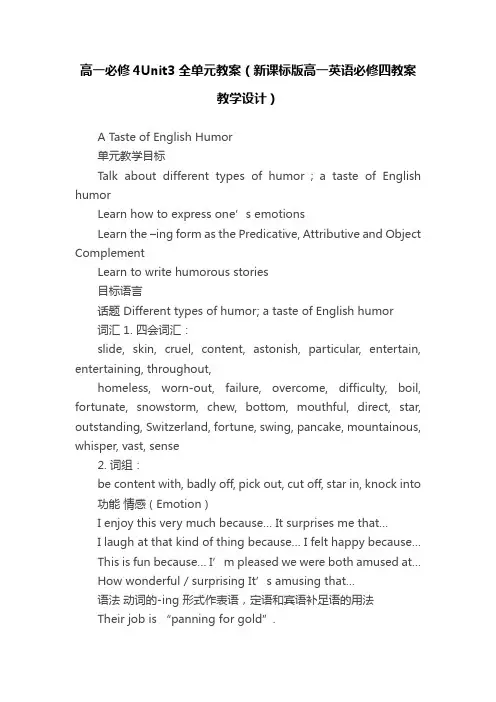
高一必修4Unit3全单元教案(新课标版高一英语必修四教案教学设计)A Taste of English Humor单元教学目标Talk about different types of humor;a taste of English humorLearn how to express one’s emotionsLearn the –ing form as the Predicative, Attributive and Object ComplementLearn to write humorous stories目标语言话题 Different types of humor; a taste of English humor词汇 1. 四会词汇:slide, skin, cruel, content, astonish, particular, entertain, entertaining, throughout,homeless, worn-out, failure, overcome, difficulty, boil, fortunate, snowstorm, chew, bottom, mouthful, direct, star, outstanding, Switzerland, fortune, swing, pancake, mountainous, whisper, vast, sense2. 词组:be content with, badly off, pick out, cut off, star in, knock into 功能情感 ( Emotion )I enjoy this very much because… It surprises me that…I laugh at that kind of thing because… I felt happy because…This is fun because… I’m pleased we were both amused at…How wonderful / surprising It’s amusing that…语法动词的-ing 形式作表语,定语和宾语补足语的用法Their job is “panning for gold”.That was the problem facing Charlie Chaplin.Do you find it funny to see someone sliding on a banana skin?课时分配1st Period Reading2nd Period Speaking3rd Period Grammar4th Period Listening5th Period Writing6th Period Summary分课时教案The First PeriodTeaching aims: Enable students to talk about some types of English humor and Chinese humor.Key points: Help students learn how to understand and enjoy English humors.Difficult points: Help students know the differences between English and Chinese in humor.Teaching aids: picturesTeaching procedure:Step 1: Lead-inShow some pictures to students, let them talk about the pictures and then ask them what they think of the pictures, whether they are funny or not.Questions: 1) Do you know who these comedians are? What makes them funny?2) Do you know other comedians who are funny in the same way?3) Have you seen any of these comedians or programmers? What do you think of them?Step 2: Warming upTask 1. Brain-stormingAsk students to name some types of humors they know. Write those they are not familiar with on the blackboard, then show some pictures and summarize.Types of humor Example of English humor Chinese humorNonverbal Charlie Chaplin Pantomimes(哑剧)刘全和,刘全利Mime and farce Mr. Bean Funny plays 陈佩斯,赵本山Verbal jokes Play on words, usually Cross talk 马季,姜昆Funny stories Two lines JokesFunny poems Edward Lear Doggerel(打油诗)Task 2. TalkingAsk students to talk about some funny stories, any English or Chinese humors they know.Task 3. Reading on P22The purpose of the reading is to introduce the kind of verbal jokes. They use a “play on words” to be funny. Let students read the three jokes and then match the joke with the explanation. Then check the answer. After that, teacher can show some other jokes on the screen.Joke 1:Patient: Doctor, I’ve lost my memory.Doctor: When did this happen?Patient: When did what happen?Joke 2:Garcia: Thank you doctor. My fever is gone.Doctor: Don’t thank me. Thank Go d.Garcia: Then I will pay the fees to God.Step 3 HomeworkAsk each student to give a joke and present it in class nextperiod.The Second Period ReadingTeaching aims: Enable students to learn what humor means and what is nonverbal humor.Key points: Help students divide the text into several parts according to the meaning.Difficult points: Divide the paragraphs and give the main ideas.Teaching aids: A recorder and a projectorTeaching procedure:Step 1. RevisionCheck homework: ask students to present their jokes in class.Step 2. Pre-readingQuestions: (1) What do you like to laugh at?(2 ) What does humor mean? Is humor always kind?Give students some time to discuss. The purpose is to help students know that different people have different taste about humor. It is difficult to say which one is better or which one is worse.Step 3. ReadingThe purpose of this reading is to introduce nonverbal humor. This reading material takes Charlie Chaplin for example. It tells us what nonverbal humor means; what is Charlie Chaplin’s style of acting; how he made a sad situation entertaining and so on.Task 1. Divide the text into several parts according to the meaning.Part One: the first and the second paragraphPart Two: the third and the fourth paragraphPart Three: the last paragraphTask 2. Give the main idea of each partThe main idea of part one: It tells us that there are two kinds of humor. One is bad, while the other can inspire people.The main idea of part two: It tells us something about Charlie Chaplin’s acting style and how Charlie Chaplin made a sad situation entertaining.The main idea of part three: it gives us a short biography about Charlie Chaplin.Task 3. DiscussionLet students have a discussion about the text, then answer some questions.Questions: (1) What is behind fun?(2 ) Why did people like Little Tramp?(3 ) Do you think Charlie Chaplin’s eating boiled shoes funny? Why?Step 4 Language points1. content (adj.): satisfied, happy, not wanting any morephrases: content with sth; content to do sthe.g. (1) She is quite content to stay at home looking after her children.(2 ) Are you content with your present salary?Content (n.): that which is contained in sthe.g. I like the style of her writing but I don’t like the content.2. inspire sb. ( with sth.) inspire sth. (in sb.): To fill sb. with thoughts, feelings or aims.e.g. His speech inspired us with hope.3. badly off: in a poor position, esp. financiallyThe opposite is “ well off”e.g. (1) They are too badly off to have a holiday.(2 ) In fact most people are better off than they were five years ago.Step 5 PracticeFinish the exercises on page 18, 19, it is a good time to consolidate the whole content of the text and the useful words and expressions from the text. It is easy for most students to finish. So leave students several minutes to finish and check the answers by showing them on the screen.Step 6 HomeworkPreview grammar by finishing Exercises 3, 4 on page 20, all the exercises on page 21.The Third Period GrammarTeaching aims: Enable students to learn how to use the –ing form as the attribute, the object complement and the predicative.Key points: Let students know the structures of the sentences with the –ing formDifficult points: Help students to tell the –ing form as the predicative and the use of the present continuous tense.Teaching aids: A computerTeaching procedure:Step 1. RevisionCheck homework: the exercises on page 20 and 21.Step 2. Word formationSuffix Example-able valuable lovable comfortable-ing amusing misleading neighboring-ful hopeful cheerful useful-less endless homeless harmless-ed excited interested moved-ish Irish childish selfish-ive active attractive expensive-ate fortunate affectionate passionate-ant important pleasant ignorant-ly friendly orderly costlyThere are ten suffixes in the chart. And there are some new words in it. But the purpose of showing this chart is to let students learn more about the adjective suffix.Step 3. Discovering useful structuresTask 1. RevisionHave a revision about the –ing form used as the subject and object. Give students some sentences to translate:(1) Talking to him is useless.(2) Smoking does harm to your health.(3) Walking is my sole exercise.(4) Collecting stamps is my hobby.(5) I suggested bringing the meeting to an end.(6) He admitted taking the money.(7) I couldn’t help laughing.(8) Your coat needs washing.Task 2. New usage of the –ing formAsk students to look at the Exercises 4 on page 20. And then wake in pairs to finish the exercises.Teacher checks the answers and give the explanations.(1) A cooking pot: A pot that is used for cooking.(2) A drinking horse: A horse that is drinking water.(3) The man sitting on the sofa is a friend of my brother’s.Here the –ing form are used as attribute.(4) I saw the man sliding on a banner skin yesterday.(5) Did you notice the man picking up that broken bottle and putting it in his bag?Hear the –ing form are used as object complement The structure of the sentence with an object complement is:Subject + Predicate + Object + Object complement(6) Her job is looking after babies.(7) What he likes is playing chess after supper.Here the –ing form are used as predictive. Pay attention to the differences between –ing form used as predicative and present continuous tense.(1) Her hobby is painting.(2) Her favorite sport is skiing.(3) This was very disappointing.(4) The test results are very discouraging.(5) She was very pleasing in her appearance.(6) His concern for his mother is very touching.(7) The photograph is missing.(8) The article was misleading, and the newspaper has apologized.In the first two sentences, the –ing form is used to show the character of the subject. In the next four sentences the words of the –ing form are all about the feelings. In the last two sentences, the words of the –ing form show some states and qualities.(9) It is snowing hard.(10) She is teaching in a night school.In these two sentences, the –ing form are used as the predicate in the present continuous tense.Step 4. Using StructuresTurn to page 56. Look at the Using Structure. There are two exercises in this part. Exercise 1 is to let students correct some errors in the sentences. This is not an easy job for most students, because it needs other knowledge, besides what the students learned today. So better leave them more time to do this exercise. For exercise 2, let students finish it in a short time. With the helpof the pictures, students can easily understand the meaning and correctly use the –ing form to finish the blanks. Teacher can check the answers in class.Step 4. HomeworkFinish all exercises on page 56.The Fourth Period ListeningTeaching aims: Enable students to understand the humor in the listening material.Key points: Train the students to get the key wards by reading the questions before listening.Difficult points: Get the main idea from the listening materials while listening.Teaching aids: A recorderTeaching procedure:Step 1. RevisionCheck homework: (1) Ask a couple of students to tell their jokes in class.(2 ) Ask some students to come to the blackboard to write their translation. After they have finished, teacher correct some errors with the whole class.Step 2. Listening ( page 23 )This is a funny story. Mary made some plum jam and left some in the pan. Five days later, her husband came home and poured the jam into the chicken. Later Mary came home and found all of her chickens were behaving strangely. What had happened? Give students two chances to listen to the story. First, go through Exercise1 and 2 to know what are the things they will do while listening. After that teacher plays the tape for them to finish Exercise 1. The second listening is to check the answers. For Exercise 2, teacher should leave some time for students to discussthe question.Questions: (1) Did you find this story funny? Give the reason.(2 ) What do you think of John’s behavior?Step 2. Listening ( page 55 )This is a story about a thief and a man. The situation is very interesting. Before listening, ask students what they would do if they find a thief in their home one day; whether they will be afraid of the thief and so on.There are three steps for this listening. At first let students read the questions to make sure that they know what they should do in this listening. Next, play the tape for the first time to let students finish Exercise 1. Then play the tape again and let the students finish the questions in Exercise 2. After that, let the students check their answers with each other. At last, listen to the tape again, teacher can make a pause where there is an question to the question, in this way students can check all the answers.Step 3. Listening ( page 58 )There are four exercises in this listening. The first one requests students to get the general idea of the material. The second one is to ask the students to know some details of the material. The third one is a question that asks the students to speculate the teacher’s feeling. And the last one is a good exercise, it gives the students another chance to practice their oral English.Step 4. HomeworkCollect as many funny stories as possible, do some preparations for the writing in the next period.The Fifth Period WritingTeaching aims: Help the students learn how to write funny stories using the target language and according to the writingsteps.Key points: T each students to write according to the writing of the writing steps.Difficult points: Help students make up a dialogue, using the target language.Teaching aid: A projectorTeaching procedure:Step 1. RevisionCheck homework: Ask several students to read their funny stories in class.Step 2. Writing ( page 23 )Give students some instructions on writing a funny story.1) Writing down your story in a logical order.2) For each of your story try to find the most interesting words you can to describe how you felt or what was happing.3) Then write out your story using these interesting words.4) Read through your story.5) Then show it to your partner. Let him/ her suggest some new and exciting words.6) Write out the story and put it into a class collection of stories.Give students enough time to finish the task and give them enough help in the writing. Tell them to give the outline first, then finish the story.Step 3. TalkingTask 1. Show students some pictures. Ask them to describe the pictures and explain what is happening, whether it is funny or not.Task 2. Imagine you want to play a trick on someone, maybe an April Fool’s trick. Work with partners, think up a funny thingand share it with the class.Step 4. Speaking and writing taskThis is a chance for students to learn limericks. It has only five lines. Three of them are longer than the other two. The longer lines all rhyme with each other and the shorter ones rhyme with each other. When introducing the poems, teacher read them first, and let the students enjoy the beauty of the rhyme. And at the same time point out that there must be two sets of rhyming words in the same poem, so the students can grasp the main feature of the poem.After reading, ask students to tell the rhyme of the first and the second poem. Let students read the poems several times and feel it. Find more limericks for students to enjoy.Give students some instructions on how to write a poem, let them think of rhyming words before writing. They need two sets of rhyming words.Step 5. Homework1) Finish Exercise 5 on Page 20.2) Make a summary about what has been learnt in this unit.The Six Period SummaryTeaching aims: 1) Learn to express the sentences that are connected with the positive and negative view of the same thing.2) Make a summary about what has been learnt in this unit.Key points: Sum up what we have learnt in this unit.Difficult points: Sum up what we have learnt in this unit.Teaching aids: A projectorTeaching procedure:Step 1. RevisionCheck homework: Ask students to present their dialogue in class.Step 2. ReadingThis reading task gives us another joke. The title is “An April fool’s joke: The Noodle Harvest”. Ask students to read the sentence : “A fool sees not the same tree that a wise man sees.” After reading, explain the meaning of the sentence. (The meaning is that the thing is the same, but the way to treat it is different between a fool and a wise man.)Give students some time to read the passage, then answer some questions and retell the whole story.Questions: 1) What do children usually do on April Fool’s Day?2) Why did people believe the programme Panorama?3) Do you think the advice that the BBC gave people who asked how to grow noodle trees was serious? Give a reason..4) What would you do to find out whether a story like this was true?Step 3. ProjectAsk students to make their own collection of jokes, funny poems or short stories. They can be the ones that they enjoy in the books that they have read. Make sure they add either a joke, a funny poem or a funny short story of their own. Copy them into a book and display it in the class so that all your classmates can enjoy them.Step 4. Summing upThis is a summary about what they have learned in the unit. Leave students some time to finish the frame. Then teacher give students a dictation about the useful words and expressions.功能句式:1. I enjoy this very much because….2. I laugh at that kind of thing because…3. This is fun because….4. How wonderful / surprising!5. It surprises me that…6. I’m pleased we were both amused at…7. I felt happy because…8. It’s amusing that…语法:1. Word formation2. The –ing form of the verb used as predicative, attribute and object complement.重点句子:1. Do you find it funny to see someone sliding on a banana skin, bumping into someone else round a Conner, or filling downa hole in the end.2. Perhaps it makes us feel more content with our life…3. He became famous for using a particular form of acting, including mime and farce.4. But he was lived by all who watched the film for his determination in overcoming difficulties and being kind even when people were unkind to him.5. Imagine you are hungry and all there is to eat is boiled shoe.6. He solved it by using nonverbal humor.7. Their job is “panning for gold”.8. This was the problem facing Charlie Chaplin in one of his most famous films.Translate the following sentences into Chinese and pay attention to the use of the –ing form.1. The two comedians performing on the stage are from Liaoning Province.2. Who is the girl walking by the river.3. The children playing the violin will give a performance next week.4. The man with sunglass standing near the car is a cross talk artist.5. The old lady talking to the children is a famous musician.6. I saw a group of policemen coming out of a green jeep and running to the building.7. I saw a dog carrying a piece of meat entering your garden.8. I heard her singing a beautiful song at the party last night.9. I got frightened when I saw a man playing with a snake in the park.10. There were some boys shouting and crying under my window, so I could not fall asleep.Step 5. Check yourself1. Do you find it difficult to understand English humor? Why?2. What role do you thing humor plays in your life?3. What language points have you learned in this unit?4. How well have you done in the exercises on the –ing form?5. Did you have any problems in understanding this unit? How did you solve them?Step 6. HomeworkDo some preparations for unit 4.~。
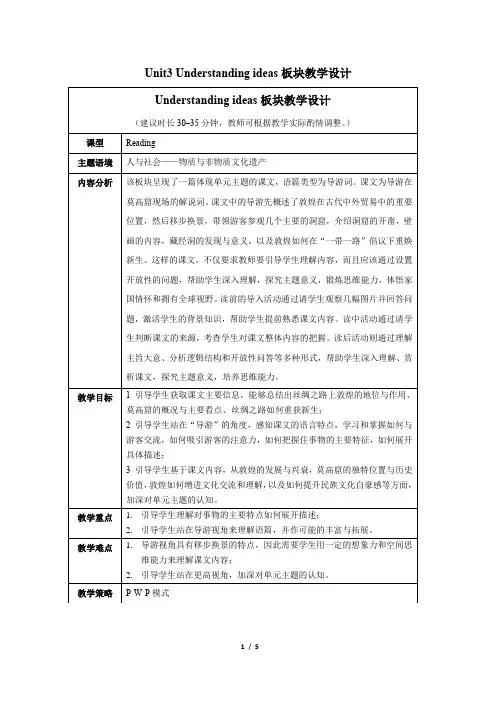
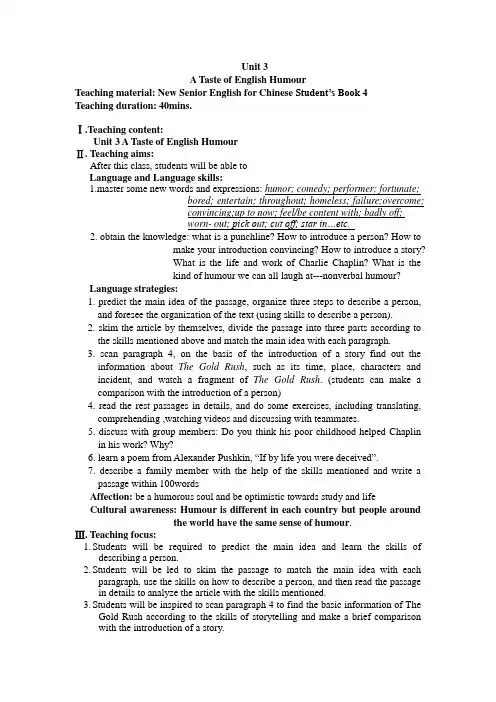
Unit 3A Taste of English HumourTeaching material: New Senior English for Chinese Student’s Book 4Teaching duration: 40mins.Ⅰ.Teaching content:Unit 3 A Taste of English HumourⅡ. Teaching aims:After this class, students will be able toLanguage and Language skills:1.master some new words and expressions: humor; comedy; performer; fortunate;bored; entertain; throughout; homeless; failure;overcome;convincing;up to now; feel/be content with; badly off;worn- out; pick out; cut off; star in…etc.2. obtain the knowledge: what is a punchline? How to introduce a person? How tomake your introduction convincing? How to introduce a story?What is the life and work of Charlie Chaplin? What is thekind of humour we can all laugh at---nonverbal humour?Language strategies:1. predict the main idea of the passage, organize three steps to describe a person,and foresee the organization of the text (using skills to describe a person).2. skim the article by themselves, divide the passage into three parts according tothe skills mentioned above and match the main idea with each paragraph.3. scan paragraph 4, on the basis of the introduction of a story find out theinformation about The Gold Rush, such as its time, place, characters and incident, and watch a fragment of The Gold Rush. (students can make a comparison with the introduction of a person)4. read the rest passages in details, and do some exercises, including translating,comprehending ,watching videos and discussing with teammates.5. discuss with group members: Do you think his poor childhood helped Chaplinin his work? Why?6. l earn a poem from Alexander Pushkin, “If by life you were deceived”.7. describe a family member with the help of the skills mentioned and write apassage within 100wordsAffection: be a humorous soul and be optimistic towards study and lifeCultural awareness: Humour is different in each country but people aroundthe world have the same sense of humour.Ⅲ. Teaching focus:1.Students will be required to predict the main idea and learn the skills ofdescribing a person.2.Students will be led to skim the passage to match the main idea with eachparagraph, use the skills on how to describe a person, and then read the passage in details to analyze the article with the skills mentioned.3.Students will be inspired to scan paragraph 4 to find the basic information of TheGold Rush according to the skills of storytelling and make a brief comparison with the introduction of a story.4.Students will be encouraged to answer questions related to the article: A Masterof Nonverbal humour, and learn how to get the structure of each paragraph and how to make your introduction convincing from the perspective of the third person.5.Students will be required to discuss with their teammates and learn some goldenqualities from Chaplin, such as optimism, independence and inspiration from life.6.Students will be asked to appreciate a poem and encouraged to carry on.7.Students will be requested to write a composition about his or her familymembers with the techniques mentioned above.Ⅳ.Teaching difficulties:1. Learn how to describe a person;2. Learn how to introduce a story;3. Realize the difference of different countries in humour;4. Cooperate with teammates and learn knowledge from group activities.5. Be aware of the importance of humour.Ⅴ.Teaching aids:Multi-media, chalks, textbook and laser penⅥ. Teaching procedures:Step 1 Leading in (Time: 5mins)1.(1min) Students will be asked what humor is.2.(1min) Introduce Lennin’s definition: H umor is a beautiful and healthy quality. (attract students’ attention by a quote from Lennin, and make them realize that humor is a kind of personality and that humor makes people laugh)3.(3mins) display some forms of humor, such as punchlines, jokes, cross talks and mimes, in the hope that students will gather some ideas that humor is different in each country, but people around the world have the same sense of humor.Step 2 Before-reading (Time: 4mins)1. (1min) Brief introduction of Charlie Chaplin2. (1min) Prediction1) Look at the pictures and the title:Who the master is and which topic is talked about2) Charlie Chaplin; humor3) The passage might be the introduction of Charlie Chaplin’s humor.3. (2mins) A panorama of how to describe a person?How to describe a person?Opinion: what kind of a person is he or she?Evidence: major life stories; impressive examplesConclusion: achievements or commentsStep 3 While Reading (Time: 23mins)(3mins) 1. Read the passage quickly, ask students to pay attention to the beginning of each paragraph, and divide the passage into three parts (using the skills of describing a person) and match the main idea with each paragraph on the screen.(5mins)2. Scan paragraph 4 quickly and find out the elements of an incident with the hope that students will make a comparison between the introduction of a person and that of an incident, and then play a video about the fragment.3.Careful Reading (14mins)Para 1. (2mins) Read the first paragraph and paraphrase one sentence1)What does "Laughter is the sun that drives winter from the human face” mean?A. Laughter is the power to drive winter away and welcome warm spring.B. Laug hter can keep one’s face warm, especially during freezing winter.C. Laughter can make people forget their problems and make them feel happy.D. Laughter can warm the earth and end winterPara 2. (2mins) Read the second paragraph and do the comprehending exercise2)Which one is NOT the hardship(困难) that Chaplin experienced in childhood?A. He was taught to sing as soon as he could speak.B. He looked after his sick mother and his brother.C. He was taught to dance as soon as he could walk.D. He became one of the most popular child actors in England.Para 3. (7mins) Read the third paragraph and finish the description of the Little Tramp and a translation of an “eye of the passage”.3)(3mins) Find the sentence that describes the physical appearance of the LittleTramp and divide it into details.(Let students have a deeper understanding of the little tramp’s image, and that the description of physical appearance contributes to the understanding of characters.)4) (4mins) Group Work: Translate (翻译) the sentence “This character was a social failure but was loved for his optimism and determination to overcome all difficulties.” (Line 1, Para 5.)该角色虽生活潦倒,但他心态积极乐观、勇于克服万难,这使得他赢得(观众)的喜爱。
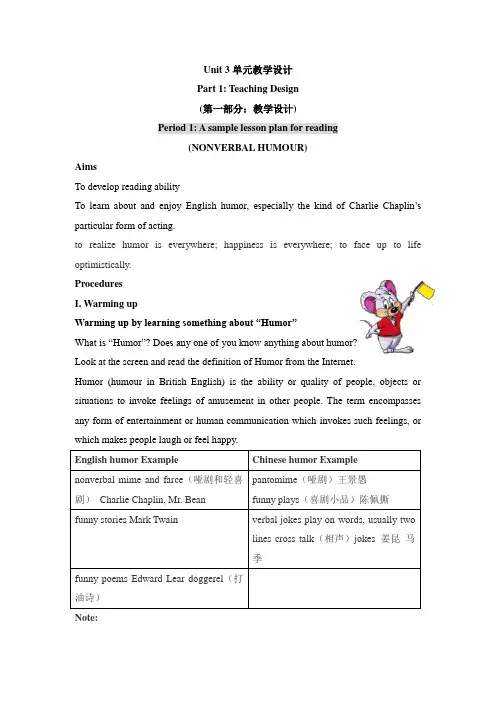
Unit 3单元教学设计Part 1: Teaching Design(第一部分:教学设计)Period 1: A sample lesson plan for reading(NONVERBAL HUMOUR)AimsTo develop reading abilityTo learn about and enjoy English humor, especially the kind of Charlie Chaplin’s particular form of acting.to realize humor is everywhere; happiness is everywhere; to face up to life optimistically.ProceduresI. Warming upWarming up by learning something about “Humor”What is “Humor”? Does any one of you know anything about humor?Look at the screen and read the definition of Humor from the Internet.Humor (humour in British English) is the ability or quality of people, objects or situations to invoke feelings of amusement in other people. The term encompasses any form of entertainment or human communication which invokes such feelings, or which makes people laugh or feel happy.Note:Humor is particular to each culture. For example, the British laugh at things that are ridiculous and enjoy parody very much. Chinese humor includes puns, extended cross talk between two comedians etc. The British also enjoys play on words(like puns) but they are more like short jokes.Warming up by watching and listeningHi, everyone! We are going to learn about A taste of English humour today. Now watch the slides/ pictures and listen to the English humour poems.Why worry?There are only two things to worry about:Either you are well or you are sick.If you are well, then there is nothing to worry about.If you are sick, there are two things to worry about:Either you will get well or you will die.If you get well, then there is nothing to worry about.If you die, there are only two things to worry about:Either you will go to Heaven or Hell.If you go to Heaven, there is nothing to worry about.But if you go to Hell, you will be so damn busyShaking hands with friends, you won´t have time to worry.Whose job ...?This is the story about four people named Everybody,Somebody, Anybody and Nobody.There was an important job to be done,and Everybody was sure that Somebody would do it.Anybody could have done it, but Nobody did it.Somebody got angry about that.because it was Everybody´s job.Everybody thought Anybody could do it,but Nobody realised that Everybody wouldn´t do it.。
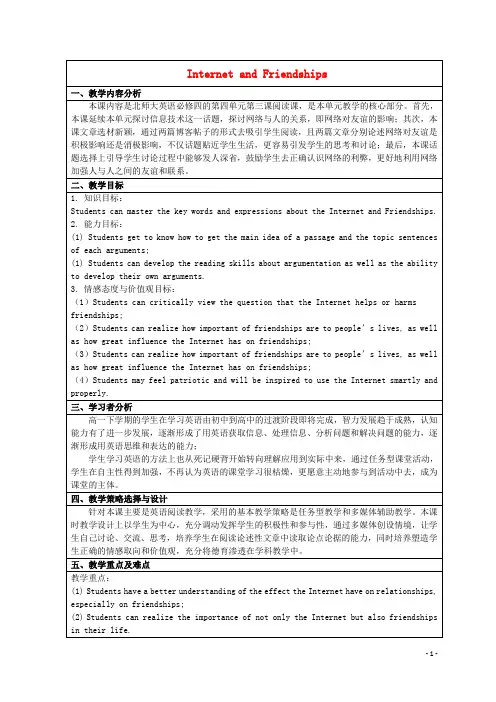
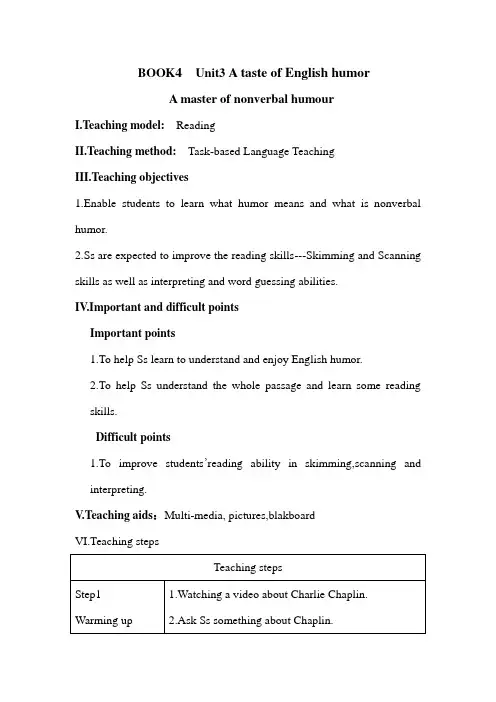
BOOK4 Unit3 A taste of English humorA master of nonverbal humourI.Teaching model: ReadingII.Teaching method: Task-based Language TeachingIII.Teaching objectives1.Enable students to learn what humor means and what is nonverbal humor.2.Ss are expected to improve the reading skills---Skimming and Scanning skills as well as interpreting and word guessing abilities.IV.Important and difficult pointsImportant points1.To help Ss learn to understand and enjoy English humor.2.To help Ss understand the whole passage and learn some readingskills.Difficult points1.To improve students’reading ability in skimming,scanning andinterpreting.V.Teaching aids:Multi-media, pictures,blakboardVI.Teaching stepsTeaching stepsStep1 Warming up 1.Watching a video about Charlie Chaplin.2.Ask Ss something about Chaplin.Step2Pre-reading Let Ss guess the main idea of the passage. according to the tittle and the picture before reading.Step3 Reading Task1 Skimming1.Ss read the passage and then match the main idea of each paragragh.Task2 ScanningSs fill in the blank to know more about Chaplin.(PW) Task3 Detailed readingAsk Ss to read the passage again and decide if the following statements are ture or false.(IW)Task4 Intensive readingChoose the best answer to the questions(IW)Step4Post-reading Retelling1.Ss retell the story by filling blank2. Discussing what else can humor bring to us in our studies and life? (GW)Step5 Summary and homework 1.Summary2.Assign homeworkVII. Blackboard arrangement.Unit3 A taste of English humorA master of nonverbal humour。
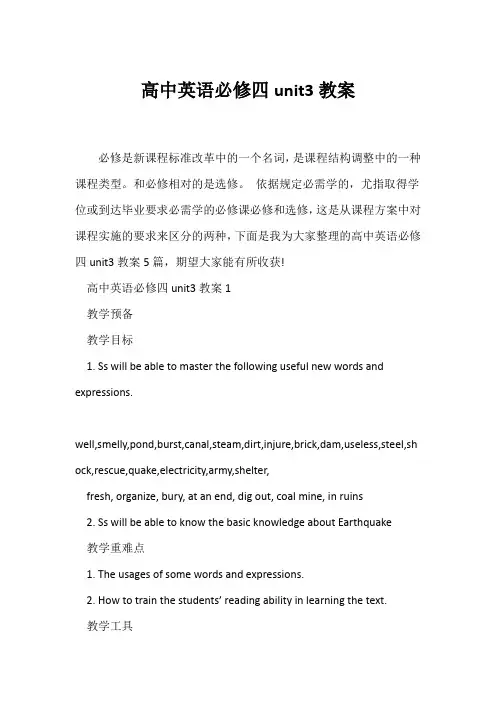
高中英语必修四unit3教案必修是新课程标准改革中的一个名词,是课程结构调整中的一种课程类型。
和必修相对的是选修。
依据规定必需学的,尤指取得学位或到达毕业要求必需学的必修课必修和选修,这是从课程方案中对课程实施的要求来区分的两种,下面是我为大家整理的高中英语必修四unit3教案5篇,期望大家能有所收获!高中英语必修四unit3教案1教学预备教学目标1. Ss will be able to master the following useful new words and expressions.well,smelly,pond,burst,canal,steam,dirt,injure,brick,dam,useless,steel,sh ock,rescue,quake,electricity,army,shelter,fresh, organize, bury, at an end, dig out, coal mine, in ruins2. Ss will be able to know the basic knowledge about Earthquake教学重难点1. The usages of some words and expressions.2. How to train the students’ reading ability in learning the text.教学工具课件教学过程Step I lead-inLet students see a short video and answer the questions1.What happened in the video Earthquakes2.How do you feel seeing the plots(情节) Students’ discussion. Step II Fast reading1. What is the passage mainly about In Tangshan ,earthquakes happened on July 28th 19762. Skim the text and answer the questionsThe type of writing (写作体裁)Narrative writingTopic sentence of Paragraph 1Sentence 1Topic sentence of Paragraph 2Sentence 2Topic sentence of Paragraph 3Sentence 1Topic sentence of Paragraph 4Sentence 1Step III Detailed readingAsk students to read the text carefully and answer the questionsTask1: What were the nature signs of the coming earthquake(选择)Para 11.Water in well( G )2. Well walls(D )3.Chickens pigs(F ) 4 .Mice (A)5.Fish(E )6. Bright lights( B)7. Water pipes(C )A. Ran out of fieldsB. in the skyC. Cracked and burstD. Deep cracksE. Jumped out of pondsF. Too nervous to eatG. Rose and fell, fell and roseTask 2 Fill in the blanksMain IdeaDetailsDamage caused byearthquakePara 2-3At _____ am, the __________ earthquake of the 20th century began . _______ burst from holes in the ground.Hard hills of the rock became rivers of ____.________ covered the ground like red autumn leaves.Two _______ and most of the bridges fell.The railway tracks were now _________pieces of _______.______ now filled the wells instead of water.Water,food,and ______________ were hard to get.The reconstruction(重建) after the earthquakePara 41. The army _____________2. Workers ____________for survivors.3._____________was taken to the city.Details:1. At 3:42 am, the greatest earthquake of the 20th century began.2. Steam burst from holes in the ground.3. Hard hills of the rock became rivers of dirt.4. Bricks covered the ground like red autumn leaves.5. Two dams and most of the bridges fell.6. The railway tracks were now useless pieces of steel.7. Sand now filled the wells instead of water.8. Water, food, and electricity were hard to get.Step IV consolidation (当堂稳固)Let students fill the blanks according to the passageStrange things were happening in the countryside of northeast Hebei. For three days the water in the village wells kept rising and1_________(fall). Farmers noticed that the well walls had deep cracks 2___________ them. A smelly gas came out of the cracks. In3_________farmyards, the chickens and even the pigs were too nervous 4__________(eat). 5_________(mouse) ran out of the fields looking for places 6________(hide). Fish jumped outOf their bowls and ponds. At about 3 am on July 28,1976, some people saw bright lights 7_________ the sky. The sound of planes could 8________(hear) outside the city of Tangshan even 9_________ no planes were in the sky.In the city, the water pipes in some buildings cracked and burst. But the one million people of the city, ________thought little of these events, were asleep as usual that night.1 falling2 in3 the4 to eat5 mice6 to hide 7in 8 be heard 9when 10 who这局部目的是让同学进一步稳固课文的内容。
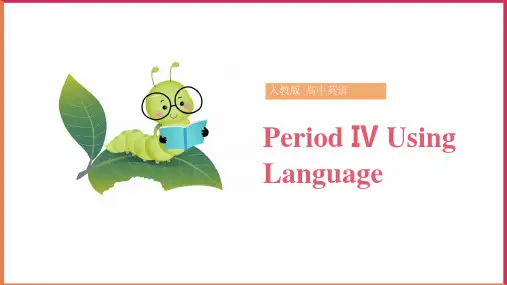
Topic Revision of Book 4 Unit 3 Type RevisionTeaching aims:知识与技能The important lang uage points of this unit过程与方法Review and practice情感态度与价值观Laughter is the sun that drives winter from the human face.Key point s The important la nguage p oints of this unit.Teachingaids:multimediaDifficult points The –ing form as the predicative, a ttribute and objectcomplement.Teaching ProceduresStep I. GreetingStep II. Review the key words and expressions of this unit.1. Ask Ss to write down the key words and expr essions according to their Chinesemeanings.2. Do some related exercises to consolidate the usages of these important languagepoints.Step Ⅲ. Review the grammar focus of this unit.A sk Ss to fill in these blanks and the teacher explain the usages of the –ing form asthe predicative, attribute and object complement.1) _______________(clean) women in big cities usually get paid by the hour.2) The man _____________ (wear) a sa d look said, "I've lost my wallet."3) All of us watched the hunter _________(bring) down the dangerous bear.4) When he woke up, he found h imself ____________ (lie) in hospital.5) The students came into the classroom_____________ (follow) th e teacher.6) His hobby is_____________(c ollect) wine bottles.7) The report is ve ry_________________(encourage).Step IV. Practice1. Grammar filling2. Cloze testStep V. Homework:1.Review the key words and expressions of Unit2.2.English Weekly (Reading Comprehe nsion)。
Unit 3 Tomorrow’s worldReadingNot just watching a film…Teaching Aims:1. To learn some information about how RealCine works, why it is better than ordinary cinema, and how it can be used in many other ways.2. To teach students the basic characteristics of a busines s proposal.3. To enable students to master the reading strategy and become more competent in reading a business proposal.Teaching Important and Difficult Points:1. Make the students understand the reading material better.2. Master the vocabulary of virtual reality.3. Improve the students’ reading ability.4. Know the structure and language for a proposal.Teaching Approaches:1.Discussion before reading to make the students interested in what they will learn.2.Fast reading to get a general idea of the text.3.Reading in detail to get the detailed information of the text.4. Pair discussion and group discussion to get students to participate in the classroom activities.Interaction Patterns: Teachers -class, individuals, pairsTeaching Aids:The multimedia, a record and a blackboard.Teaching Procedures:Step 1 Lead-inShow the video of Avatar and ask students:Do you like this film? Can you imagine how you feel when you are actually in the film? Show some pictures of 3D films and tell them virtual reality could change the way we watch films.3D film。
高中英语必修四unit3教案高中英语必修四 Unit 3 教案教学目标1.通过本单元的学习,学生能够正确理解并运用相关词汇、短语以及语法知识;2.能够熟练运用所学知识,进行听、说、读、写的活动;3.能够培养学生的英语交际能力,提高学生的听力和口语水平。
课时安排本单元共分为5个课时,安排如下: 1. 第一课时:课文阅读与理解(50分钟) 2. 第二课时:语法重点讲解与练习(50分钟) 3. 第三课时:听力训练与口语练习(50分钟) 4. 第四课时:写作技巧培养(50分钟) 5. 第五课时:综合能力测试与复习(50分钟)教学内容与步骤第一课时:课文阅读与理解1.导入(5分钟)–介绍本单元的主题和学习目标;–学生回忆相关的词汇和短语。
–学生自主阅读课文,理解文章大意,并标出生词;–学生分小组讨论课文内容及问题。
3.阅读理解(25分钟)–学生带着问题阅读课文,回答问题并进行讨论;–教师组织小组讨论问题的汇报。
4.总结与拓展(10分钟)–教师对学生的表现进行评价,总结本课时的学习要点;–教师布置相关的课外阅读作业。
第二课时:语法重点讲解与练习1.复习与导入(5分钟)–教师复习上课内容,并引入本课时的语法主题。
2.语法讲解(20分钟)–教师通过PPT讲解本课时的语法知识,包括虚拟语气的用法和结构。
3.练习与巩固(20分钟)–学生进行虚拟语气的练习题,巩固所学知识;–学生分组进行语法对话练习,培养口语能力。
–教师让学生以小组形式编写虚拟语气的对话,并进行表演。
第三课时:听力训练与口语练习1.复习与导入(5分钟)–教师复习上课内容,并引入本课时的听力和口语主题。
2.听力训练(20分钟)–教师播放听力材料,学生进行听力填表练习;–教师带领学生一起检查答案。
3.口语练习(20分钟)–学生分组进行对话练习,练习表达自己的观点和想法;–学生进行角色扮演,模拟实际情境进行口语练习。
4.总结与拓展(5分钟)–教师对学生的表现进行评价,总结本课时的学习要点;–教师布置相关的口语练习作业。
高中英语必修四unit3教案(一)高中英语必修四Unit 3 Teaching Plan1. Basic Information•Topic: Environmental Protection•Level: High School English•Unit: 4 (out of 8)•Duration: 5 class periods2. Learning ObjectivesBy the end of this unit, students will be able to: - Understand and use vocabulary related to environmental protection. - Identify and analyze different environmental issues. - Discuss the importance of environmental protection. - Develop critical thinking skills through group discussions and debates. - Write an essay expressing their ideas on environmental protection.3. Lesson PlanLesson 1: Introduction to Unit 3 (1 class period)•Start the class with a brief discussion on the importance of environmental protection.•Present key vocabulary related to the topic.•Give examples of different environmental issues. •Assign relevant reading materials for self-study. Lesson 2: Vocabulary and Reading Comprehension (1.5 class periods)•Review and reinforce vocabulary through interactive exercises:–Matching words with definitions.–Completing sentences with appropriate words.–Creating sentences using vocabulary words. •Assign relevant reading passages for students to read and summarize for the next class.Lesson 3: Reading Analysis and Class Discussion (1 class period)•Divide the class into small groups.•Ask each group to analyze and discuss the main ideas and arguments presented in the assigned readings.•Encourage students to share their opinions and ask questions during the discussion.•Lead the class in a whole-group discussion to summarize the main points.Lesson 4: Debate Preparation (1 class period)•Divide the class into two teams: “For” and “Against”environmental protection.•Allocate time for each team to research and prepare arguments for their positions.•Provide guidance on structuring and presenting arguments effectively.•Facilitate practice debates within each team.Lesson 5: Debate and Essay Writing (1.5 class periods)•Conduct the debate between the two teams.•Encourage students to express their opinionsconvincingly and respectfully.•After the debate, assign an essay writing task:–Topic: “The Role of Individuals in Environmental Protection”–Provide guidelines on structuring and supporting arguments.–Allocate time for students to brainstorm ideas and write an essay.4. Assessment•Assess students’ understanding through active participation in class discussions.•Evaluate vocabulary comprehension through interactive exercises.•Grade the debate based on argument clarity, presentation skills, and rebuttal capability.•Evaluate the essays based on structure, language use, and supporting evidence.5. Additional Resources•Relevant reading materials on environmental protection. •Online platforms or environmental organization websites for additional research.•Examining sample debate videos for reference and inspiration.•Model essays for students to analyze and learn from.•Chart paper and markers for group discussions and debate preparation.6. Differentiation•For students who have difficulty with vocabulary, provide extra practice exercises and flashcards.•For students who need more scaffolding, provide a list of key vocabulary words and definitions in advance. •For advanced students, assign additional readings or research projects related to environmental protection. •Provide opportunities for visual learners to create posters or infographics related to the topic. •Incorporate technology by using online resources for research and interactive activities.7. Homework•Assign reading passages and comprehension questions for students to complete and discuss in the next class. •Ask students to research and prepare arguments for their debate positions.•Require students to complete their essay writing assignment and submit it for review.8. Assessment Criteria•Active participation in class discussions and activities •Vocabulary comprehension through exercises and application•Quality of analysis and discussion during the group and whole-class discussions•Clarity, persuasiveness, and logical reasoning in the debate presentations•Structure, language use, and support of arguments in the essay writing9. ConclusionThis teaching plan aims to engage students in learning about environmental protection by providing variousactivities and opportunities for critical thinking and expression. It encourages students to develop their own opinions while also engaging in respectful debates and collaborative discussions. Through this unit, students will not only improve their English language skills but also develop a deeper understanding of the importance of environmental protection.。
Unit 3 Tomorrow’s worldProjectWriting a science fiction storyTeaching Aims:To learn what a science fiction story is like and how to write a science fiction story. Teaching Important and Difficult Points:How to make students understand the science stories better.How to write a science fiction story.Teaching Approaches:Asking-and-answering activity.Individual, pair or group work to make every student work in class.Teaching Aids:Multimedia and a blackboardTeaching Procedures:Step 1 Lead-in●Have you ever read any science fiction stories? Do you like them?●Do you know about some science fiction writers? Who are they?●Have you ever heard of Jules Verne or H. G. Wells?Show them the pictures of Jules Verne and H.G. Wells, tell them about these two persons briefly.Step 2 Reading●Journey to the Centre of the EarthRead the first story written by Jules Verne. Then answer the following questions.1.With whom did Professor Lindenbrock make the journey?2.What was the destination of the journey?3.How di d they go there?4.What did they see during their journey?5.Which do you think was the most thrilling experience during th eir journey, why?●Time machine1.Lead to the second science fiction story.•Have you ever read about or seen a film about a time machine?•What do you think a time machine can be used to do?•Many people are in terested in such a machine. Can you thi nk of the reason(s)?2.Show them a video about time machine.3.Ask them to read the story and think about the following questions.●What did the writer dec ide to see using the time machine the writer had made?●Which year did the writer go to? What did the writer find there?●The writer described a picture about the future. What is his idea about the futureof the world? What is your opinion about the future?4. Ask them to discuss.If you had a time machine, what would you like to see, the future or the past? Why?What would you expect to see there?Step 3 Writing a science fiction story (Group Work)Ask them to discuss the q uestions on page 59.●What interesting science fiction stories have you read?●Which one do you like best? Why?●What would be a good setting for a story?●Who will be your main charac ters?●What do the main characters do?●How many paragraphs will your story have?●Who will write each paragraph?●Who will read the story to your classmates?Step 4 Homework1. Finish the WB exercises (D1, D2)2. Finish writing a science fiction story.。
教学设计A taste Of English humor一、教材分析(教材的地位及作用):该课选自新人教版高中英语必修4第3单元阅读部分。
该部分以“无声的幽默”为题,介绍了世界著名的电影演员、喜剧大师查理卓别林以及他在无声电影时代的精湛表演。
他运用滑稽、夸张的动作表情,让观众在捧腹大笑之余,体会在琐屑、卑微之中隐藏的深刻本质。
同时鼓励学生保持乐观的人生态度,培养幽默感,陶冶情操。
还要通过阅读这篇课文,进一步提高学生听、说、读、写的综合素质能力。
以此达到《英语课程标准》中提出的“让学生通过感知,体验,实践,参与和合作等方式感受成功。
形成积极的学习态度,促进语言交际应用能力的提高。
二、学情分析高一学生,虽然经过了初中三年的学习,但所掌握的单词量少,口语表达能力弱,又缺乏良好的英语语言环境,学生学习英语的兴趣低。
这些原因导致了课堂上师生的配合不够融洽。
但学生对课堂中设置的学习活动参与性较好,在同组同学的配合及教师的帮助下可以取得良好的效果。
因此,将知识直观呈现,从易入手,使学生感觉到容易理解容易掌握,调动学生的学习兴趣和积极性成为教师要攻克的主要难关。
借助多媒体,让学生感受真实情境,通过对本的学习提升学习英语的兴趣。
三、确立教学目标,重难点根据课程标准的要求,及本课在教材中所处的地位和作用,结合学生的实际学情,确立教学目标及重点与难点:(一)教学目标1.知识目标:通过对阅读的学习,进行全面、整体理解,引发思考,达到强化学生语言意识、积累语言经验的目的。
从而提高英语的口头与书面表达能力。
2.过程与方法目标:通过Reading简单了解无声幽默大师---卓别林。
3.情感、态度与价值观目标1)通过对阅读的学习,鼓励同学保持乐观的人形成积极向上的生活态度生态度,培养幽默感,2)通过积极参加课堂上各种英语实践活动,培养学生学习英语的强烈兴趣,乐于参加各种活动的积极情感,并提高实际交际能力和与他人合作的能力。
(二)教学重点和难点重点:阅读技巧和阅读能力的培养。
必修四unit3 A taste of English humorReading: A master of nonverbal humor 教学设计在高中新课改的实施过程中,阅读课涉及的内容越来越丰富,要求学生了解的东西也越来越多,加上高一学生基础知识与基本技能的不足,所以学生在课堂阅读中遇到的难度也在不知不觉加大。
那么,在课堂阅读中指导学生恰当地使用阅读技巧,并合理设置有效的课堂活动,帮助他们顺利理解文章,提高阅读能力,成为教师教学设计的重心。
本节课的教学设计正是围绕这个重心展开的。
一、教材分析本节课为人教版英语必修四第三单元第二课时的阅读课。
本单元的中心话题是“幽默”,这节课以“非语言幽默大师”为题,介绍世界著名的电影演员,喜剧大师查理·卓别林以及他在无声电影时代的精湛表演,特别是在著名电影《淘金记》中,他运用滑稽、夸张的动作表情,让观众在捧腹大笑之余体会在琐屑、卑微之中所隐藏的深刻本质。
二、学生分析本文是一篇描写人的文章,涉及幽默这一话题,学生阅读兴趣较大,但高一学生由于英语基础知识和基本技能都是一般水平,因此调动学生学习兴趣很关键。
本文难度适中,加之第一课时的热身训练已经让学生对不同地域与国家的幽默表现有了一定的了解,所以这节课在激发学生阅读兴趣的同时,通过组织丰富的课堂活动,促进学生的探究式、自主式学习,让学生成为课堂的主体,从而进一步提高他们的英语阅读方法与技能。
考虑到学生的个体差异,教学过程中设计的活动要兼顾不同学习水平的学生,使全班所有学生都能积极参与课堂活动,主动探索,勇于表现,学有所获,从而使学生真正成为课堂的主人,体现新课改的精神实质。
三、教学目标分析(一)【知识与能力】知识目标:了解非语言形式的幽默艺术。
了解卓别林的生平以及他在无声电影中的精湛表演。
帮助学生习得并掌握本文出现的词汇、语言表达方式,同时欣赏文章中的优美句式。
能力目标:帮助学生进一步提高阅读中猜词义、略读、查读、跳读、归纳、总结等能力。
引导学生进一步了解与体会V-ing形式在文中的呈现。
(二)【过程与方法目标】1.通过限时阅读、速读等阅读方法逐步提高学生的阅读技巧。
2.课堂活动的设计体现循序渐进,引导学生自主探究地学习与互动,帮助学生打开思维空间。
(三)【情感态度与价值观目标】1.通过对幽默的了解以及对卓别林的走近,鼓励学生保持乐观的人生态度,培养幽默感,陶冶情操。
2.欣赏文中的优美句子,激发学生的语言学习兴趣与热情。
(四)教学重点与难点重点:1.如何在有限的时间内引导学生参与课堂活动,最大限度地激发学习兴趣。
2.各种阅读技巧的交错使用以帮助学生稳步提高阅读能力。
难点:1.引导学生如何正确捕捉信息,归纳总结段落及全文大意。
2.培养学生对文章整体结构的把握和分析人物个性,学会学后简介人物。
四、教学方法1.活动式教学。
即组织各种阅读方法交融的课堂活动,引导学生积极参与阅读。
2.图表式教学。
即以图表形式在课件中呈现的文章结构图,帮助学生立体展现全文内容。
3.启发讨论式教学。
即设计讨论话题,启迪学生思维,引发课堂竞争与互动,培养学生创新思维。
五、教学媒体A computer, a projector, a recorder, the courseware designed for this period.六、教学程序设计与分析Step1. Presentation (in 3 minutes)The teacher presented some pictures of Charlie Chaplin and asked the students what they know about him. Then encourage them to predict the content of this text.设计意图:通过图片形象生动地引出本文要介绍的主人公,通过提问激发学生对卓别林更多了解的欲望,预测新课内容,为阅读做好准备,引起学生对问题的探究,调动他们阅读的积极性。
Step 2. ReadingThe teacher is to organize five reading activities to lead the students to read the text. Activity 1: Listening and skimming ( in 3 minutes)Before reading, let the students look at the screen and listen to the tape. Show the easy questions with four answers on the screen and tell them to choose the best one after skimming.Questions like this:C haplin’s type of acting is ____.A. comedyB. cross talkC. mimeD. sketch设计意图:限时阅读培养学生快速捕捉信息的能力,并在阅读中结合速读与跳读技巧的使用,简单的提问也能迅速激发学生阅读的成功感与兴趣。
Activity 2: Scanning (in 8 minutes)Give the students some questions about the text before scanning. These questions are related to the basic information about Chaplin and they are about the details of the text.Especially, question the students about the description of the little tramp and draw a lively picture of his.Questions like this: 1.Why do People enjoy seeing other people’s bad luck ?2. When was Charlie Chaplin born?While answering the questions, lead the students to finish the chart on the screen.设计意图:此次查读问题涉及文章细节理解,且问题设计的难度稍微加大,让学生感觉到阅读的挑战性,引导他们探究式学习,培养他们正确捕捉重点细节的能力,图表的立体呈现也能帮助学生加快对文章的深入理解。
在阅读中指导学生切忌读时粗枝大叶,误解信息,偏离了准确性。
Activity 3: Further careful reading (in 8 minutes)Read the passage again and summarize the main idea of each paragraph.Direct the students how to grasp the topic sentence of each paragraph.Para1: Why people needed cheering up.Para2: What Charlie Chaplin’s childhood was like.Para3: …Para4: …Para5: …设计意图:此次活动旨在培养学生的语言组织和归纳能力,可指导学生如何寻找每段主题句或关键词,帮助他们完成段落大意,缓解学习难度。
Activity 4: competition (in 8 minutes)Then present some T or F statements on the screen and start a competition. The teacher inspired the students to hand up as quickly as they can.Such as:1. Charlie Chaplin was poor when he was a small boy.2. People who don’t know English cannot enjoy Chaplin’s films.3…4…5…6…设计意图:此次活动旨在阅读的基础上,再次检查学生读后对课文理解的准确性,并引入竞争机制,启发学生积极向上、敢于挑战的品质;同时活跃课堂气氛。
Activity 5: Enjoy some beautiful sentences including those with v-ing forms.(in 3 minutes)设计意图:通过欣赏美文,走近v-ing 分词,让学生享受语言学习的美感,再次增进阅读兴趣,同时对下一节的语法学习做好铺垫。
Step 3.Discussion (in 5 minutes)Give the students some questions to discus s Chaplin’s characters.1. Do you think his poor childhood helped him in his work? Why?2. Why did people like The Little Tramp?3. Why do you think he was so successful?Tell the students to discuss the questions in pairs or in groups.At last, let them report their opinions to the class.设计意图:此次活动旨在引导学生通过讨论认识到成功后的艰辛,使他们正确看待生活中的挫折和失意,在学生自主合作学习的同时对其进行思想教育。
Step 4: Sum up and retell the text (in 5 minutes)Give the students a passage with some blanks to fill in.Students can be led to sum up and retell the text.Retell the text by filling in the following blanks.Charlie Chaplin was born in a _____ family in _____. By his ______, he had become one of the most popular ______actors in England. As time went by, he grew more and more ________ as his charming ________ “the little _______” …设计意图:引导学生根据这段设空的短文来总结本文,教师同时可由此总结本堂课。